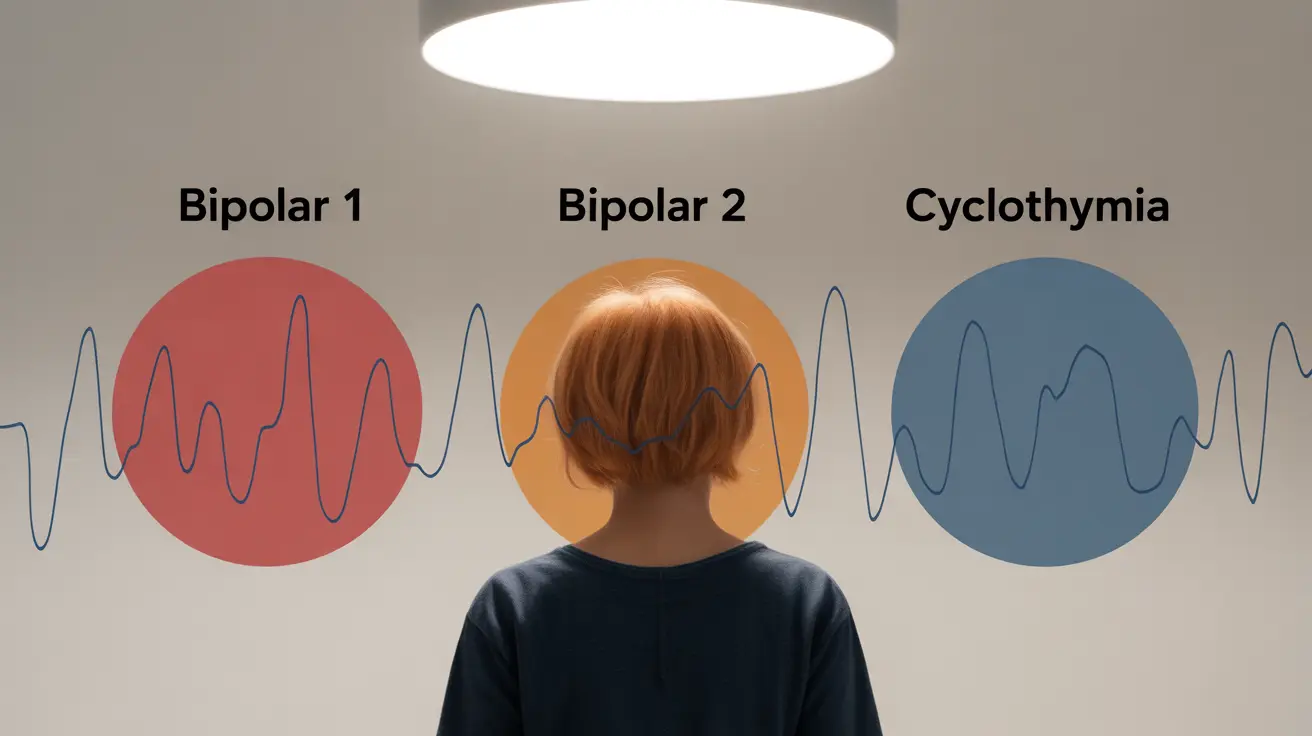Living with mood disorders can be challenging, and understanding the distinctions between different types of bipolar disorders is crucial for proper diagnosis and treatment. While bipolar 1, bipolar 2, and cyclothymia all involve mood fluctuations, they differ significantly in their symptoms, severity, and impact on daily life.
This comprehensive guide explores the key differences between these three conditions, helping you better understand their unique characteristics, diagnostic criteria, and treatment approaches.
Key Characteristics of Each Disorder
Bipolar 1 Disorder
Bipolar 1 disorder is characterized by the occurrence of at least one manic episode, which may be accompanied by major depressive episodes. Manic episodes in bipolar 1 typically:
- Last at least 7 days
- Involve severely elevated mood and energy levels
- Often require hospitalization
- Can include psychotic features
- Significantly impact daily functioning
Bipolar 2 Disorder
Bipolar 2 disorder is distinguished by the presence of hypomanic episodes and at least one major depressive episode. Key features include:
- Less severe manic symptoms (hypomania)
- More frequent depressive episodes
- No full manic episodes
- Less likely to require hospitalization
- Maintains better functional capacity during episodes
Cyclothymia
Cyclothymia represents a milder form of mood disorder, characterized by chronic fluctuating moods. Notable features include:
- Multiple periods of hypomanic and depressive symptoms
- Symptoms don't meet criteria for major depression or mania
- Mood fluctuations lasting at least two years
- Brief periods of stable mood
- Less severe impact on daily functioning
Severity and Duration Differences
The severity and duration of mood episodes vary significantly among these conditions. Bipolar 1 presents with the most severe manic episodes, while bipolar 2 features prominent depression with milder hypomanic episodes. Cyclothymia involves chronic but less severe mood fluctuations that don't reach the threshold of major mood episodes.
Diagnostic Criteria and Assessment
Mental health professionals use specific criteria from the DSM-5 to diagnose these conditions. Accurate diagnosis requires:
- Detailed patient history
- Assessment of symptom severity and duration
- Evaluation of impact on daily functioning
- Consideration of other potential mental health conditions
- Documentation of mood patterns over time
Treatment Approaches
Medication Options
Treatment strategies vary based on the specific diagnosis:
- Bipolar 1: Mood stabilizers, antipsychotics
- Bipolar 2: Mood stabilizers, antidepressants with careful monitoring
- Cyclothymia: Lower doses of mood stabilizers, sometimes psychotherapy alone
Psychotherapy
All three conditions benefit from various forms of psychotherapy, including:
- Cognitive Behavioral Therapy (CBT)
- Interpersonal and Social Rhythm Therapy
- Family-focused therapy
- Group therapy support
Frequently Asked Questions
What are the main differences in symptoms between bipolar 1, bipolar 2, and cyclothymia?
Bipolar 1 involves full manic episodes that can include psychosis and require hospitalization. Bipolar 2 features less severe hypomanic episodes but significant depression. Cyclothymia presents with chronic, milder mood fluctuations that don't meet criteria for major episodes.
How is cyclothymia different from bipolar 1 and bipolar 2 in terms of severity and mood episode duration?
Cyclothymia involves less severe mood swings that occur more frequently but with shorter duration compared to bipolar 1 and 2. The symptoms are chronic but don't reach the intensity of full mania or major depression.
What are the diagnostic criteria that distinguish bipolar 1, bipolar 2, and cyclothymic disorder?
Bipolar 1 requires at least one manic episode. Bipolar 2 requires hypomanic episodes and at least one major depressive episode. Cyclothymia requires at least two years of fluctuating hypomanic and depressive symptoms that don't meet full criteria for major episodes.
How do treatment approaches vary for bipolar 1, bipolar 2, and cyclothymia?
Treatment intensity typically correlates with severity: bipolar 1 often requires stronger medication combinations, bipolar 2 may need focused depression treatment, and cyclothymia might be managed with milder interventions or therapy alone.
Can cyclothymia be misdiagnosed as another mental health condition, and how can it be accurately identified?
Yes, cyclothymia can be misdiagnosed as depression, anxiety, or personality disorders. Accurate identification requires careful tracking of mood patterns over time, detailed history-taking, and assessment by a qualified mental health professional.




